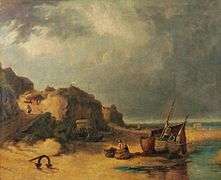Norwich School of painters


The Norwich School of painters,[1][2] founded in 1803 in Norwich, was the first provincial art movement in Britain. Artists of the school were inspired by the natural beauty of the Norfolk landscape and owed some influence to the work of landscape painters of the Dutch Golden Age such as Hobbema and Ruisdael.
History
The Norwich Society of Artists was founded in 1803 by John Crome and Robert Ladbrooke as a club where artists could meet to exchange ideas. Its aims were "an enquiry into the rise, progress and present state of painting, architecture, and sculpture, with a view to point out the best methods of study to attain the greater perfection in these arts." The society's first meeting was in "The Hole in the Wall" tavern; two years later it moved to premises which allowed it to offer members work and exhibition space. Its first exhibition opened in 1805, and was such a success that it became an annual event until 1825. The building was demolished but the society re-opened three years later, in 1828, as "The Norfolk and Suffolk Institution for the Promotion of the Fine Arts" at a different venue and exhibitions continued until 1833.[3]
The leading light of the movement was John Crome who attracted many friends and pupils until his death in 1821. The mantle of leadership then fell on John Sell Cotman, a member of the society since 1807, who continued to keep the society together until he left Norwich for London in 1834. The society effectively ceased to exist from that date.
The Norwich School's great achievement was that a small group of self-taught working class artists were able to paint with vitality the hinterland surrounding Norwich, assisted by meagre local patronage. Far from creating pastiches of the Dutch 17th century, Crome and Cotman, along with Joseph Stannard, established a school of landscape painting which deserves greater fame; the broad washes of Cotman's water-colours anticipate French impressionism.
One reason the Norwich School artists are not so well known as other painters of the period, notably Constable and Turner, is because the majority of their canvases were collected by the industrialist J. J. Colman (of Colman's mustard fame), and have been on permanent display in Norwich Castle Museum since the 1880s. This lack of wider exposure was remedied in 2001, when many of the school's major works were exhibited outside Norwich for the first time at the Tate Gallery, London.
In 1986 Norwich Castle museum acquired a late masterwork by John Crome entitled Back of New Mills Evening dated circa 1812-1819. It is interesting to note that its composition includes a small boy trailing a toy boat from the stern of a boat. The identical motif occurs in Joseph Stannard's masterwork Thorpe Water Frolic of 1828. Stannard had requested tuition in painting from Crome as a young man but Crome refused and Stannard broke away from the 'Norwich School', his relatives and friends never forgiving Crome for the snub to him. Such was the intense rivalry between the major painters of the Norwich School.
Members and associates
- Henry Bright
- John Joseph Cotman
- John Sell Cotman
- John Crome
- John Berney Crome ("Young Crome")
- Edward Thomas Daniell
- Robert Dixon
- David Hodgson
- Robert Ladbrooke
- Alfred Stannard
- Eloise Harriet Stannard
- Emily Coppin Stannard
- Joseph Stannard
- James Sillett
- James Stark
- John Thirtle
- George Vincent
London members of the society included:
See also
References
- ↑ Norfolk Museums
- ↑ Norwich school of painters ("Literary Norfolk")
- ↑ Holme, Geoffrey (Ed.). The Norwich School (The Studio Ltd., 1920). p. 1.
Further reading
- Brown, D. B. & Hemingway, Andrew & Lyles, Anne. Romantic Landscape, The Norwich School of Painters (Tate Gallery Publishing, 2000).
- Fawcett, Trevor. The rise of English provincial art: artists, patrons, and institutions outside London, 1800-1830 (Clarendon Press, 1974). ISBN 0-19-817328-8
- Hemingway, Andrew. (1979) The Norwich school of painters, 1803-33. Oxford: Phaidon. ISBN 9780714820019
- Moore, Andrew W. The Norwich School of Artists (HMSO/Norwich Museums Service, 1985, repr. 1995).
- Rajnai, Miklos & Stevens, Mary. The Norwich Society of Artists, 1805-1833: a dictionary of contributors and their work (Norfolk Museums Service for the Paul Mellon Centre for Studies in British Art, 1976).
- Scott, Peter Kennedy. A Romantic Look at Norwich School Landscapes: By a Handful of Great Little Masters. (Dec 1998) ISBN 0-9534711-0-1. ISBN 978-0-9534711-0-2
- Walpole, Josephine. Art and artists of the Norwich School (Antique Collectors' Club, 1997). ISBN 1-85149-261-5
External links
- The Norwich School (Andrew Graham Dixon archive)
- Norfolk Museums service
